Apple’s Screen Time feature provides one of the most powerful weapons in the battle to protect healthier device use. It allows parents to monitor and limit the time kids spent on a mobile device, and even restrict some apps. Yet, amidst its utility, a common question arises: Can my child turn off Screen Time?
This is a genuine question more parents have been pondering on. Unraveling this issue may aid in wisely using Screen Time.
This article will focus on how to disable iPhone Screen Time and offer practical tips for parents to keep oversight while encouraging kids’ responsible device usage.
How does iPhone Screen Time work?
The iPhone Screen Time is a multi-faceted parental control tool. It will enable you to view and manipulate your child’s device usage.
With the help of these features, parents can create a personalized experience for their children that promotes good tech habits and limits the overuse of devices.
Here’s how it works:
- App limits: You can set daily time limits for particular apps or categories, including social networks, online games, or entertainment. Once the limit is reached, it will be blocked until the next day or if you give more time.
- Downtime: This function allows you to program specific times at which certain apps cannot be in use. The only allowed thing is making calls or educational applications.
- Always allowed: Some functions or activities can be designated as “always allowed”. Those are accessible even during offline mode or even after the app limit has been reached.
- Content & privacy restrictions: It enables you to set up specific content and privacy preferences, which include blocking unsuitable content, restricting browsing, and managing privacy settings.
- Communication limits: You can control your child’s ability to communicate with specified contacts and particular time periods.
- Activity reports: Here you can check reports of a child’s device usage, such as app activity, websites visited, and the hours spent on particular apps or categories.
How to set an iPhone Screen Time Passcode?
A Screen Time passcode is something you need to prevent your child from bypassing or even shutting off the restrictions you set up.
The passcode acts as a barricade, to protect the Screen Time settings from being edited by the non-authenticated individual.
Here’s how you can set up a Screen Time passcode on your iPhone:
- Open Settings > Tap “Screen Time”.
- Click “Use Screen Time Passcode” or “Change Screen Time Passcode” if you already have one.
- Enter a 4-digit passcode twice to verify.
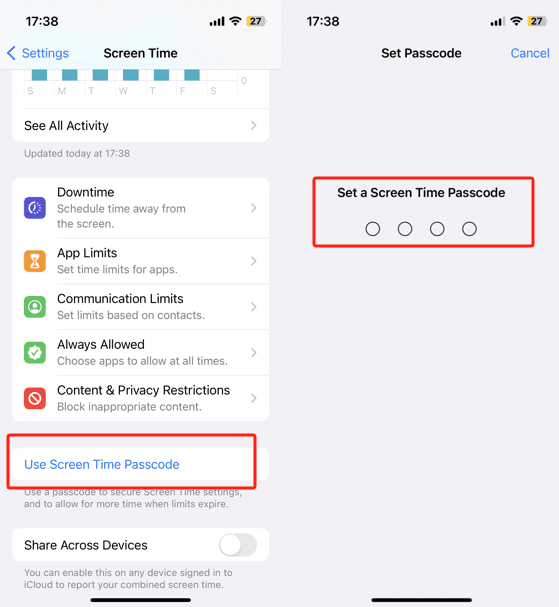


You can choose the Parent Passcode Recovery option, which enables you to recover the passcode in case you forget it.
Once setting up a passcode, any attempt to disable or change Screen Time settings will be denied without passcode.This helps you prevent your child from bypassing the limits that you provided without your special permission.
Set the usage time for each app and arrange your child’s phone use appropriately.
How to turn off iPhone Screen Time with passcode?
While Screen Time effectively helps parents to control their children’s device usage, sometimes you may need to temporarily disable it.
However, you will need the Screen Time passcode you established before. Here’s how to turn off iPhone Screen Time with the passcode:
- Open the Settings > “Screen Time.”
- Enter your Screen Time password when requested.
- Swipe down and tap the “Turn Off Screen Time” button twice to confirm your decision.
Finish these steps, Screen Time will be deactivated and all the restrictions and schedules you created will be removed. The child will be without any access restrictions to the device and its apps.
How to turn off Screen Time without a passcode?
Children may try to turn off Screen Time without the passcode, either because of pure curiosity or a desire they have to overlook the limitations you’ve imposed.
Although there are several ways they can attempt to do this, all have significant drawbacks and risks.
1. Signing out of the iCloud account:
If your child knows your Apple ID password, they may attempt to sign out of your iCloud account on their device. This will delete Screen Time and all the settings linked to it.
Yet on the other hand that implies not having iCloud services with iMessage, Photos and backups at the same time.
2. Resetting the screen time passcode:
If your kid can trace your Apple ID login information, they can easily reset the Screen Time password on iCloud.
This involves logging onto the iCloud site, accessing the screen time settings, and resetting the password.
These credentials may not always be a good idea since it depends on access to your Apple ID password and you might become suspicious if it sends notification emails.
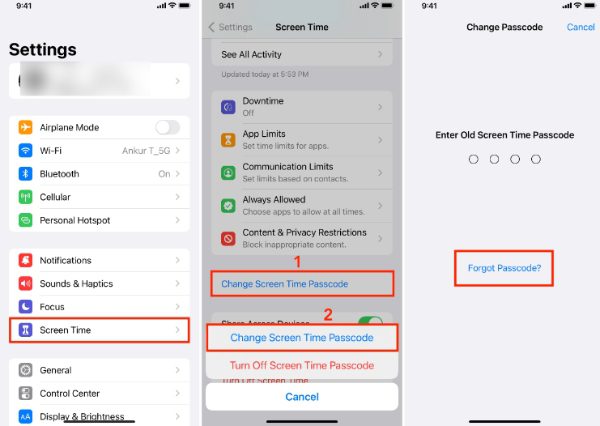


3. Factory resetting the iPhone:
Another potential risk is that if your child does not know your Apple ID as a parent, he/she might attempt to factory reset the iPhone. This will remove Screen Time along with all data and settings.
This is an extreme measure and will lead to the deletion of all data, applications and system configurations from the device.
However, it may not be a choice if you have an activation lock or some other security measures on your device.
Here are the steps: Settings > General > “Transfer or Reset iPhone” > “Erase All Content and Settings”.



4. Using restrictions:
If you have not activated the “Restrictions” feature of Screen Time, your child could try to go around Screen Time by accessing the “Restrictions” settings.
But if you have set a Restriction passcode, which is different from the Screen Time passcode, then this method will not work.
Answer: Can my child turn off screen time?
Though Screen Time allows parents to set up digital limits, there is a likelihood of the child turning it off after getting hold of the required credentials and passcodes.
Sharing your Apple ID password or Screen Time passcode with your child would mean that they will be able to simply bypass the Screen Time limit you have set for them.
Nonetheless, without those details, it is a bit more complex for the child to disable Screen Time. They would have to use the options that would affect the data and settings directly, such as factory resetting the device.
Above all, the safety of your Apple ID and Screen Time passcode from kids is significant. Besides that, it would be a good idea to change your passwords regularly so as to keep the integrity of the parental controls you have set up.
How do I turn on/off Screen Time on my child’s phone remotely?
You can switch off Screen Time on your child’s iPhone or iPad from a distance by employing Apple’s Family Sharing.
With Family of Sharing, you can establish Screen Time limits and other controls across devices linked to your family group.
Here’s how you can turn off Screen Time on your child’s device remotely:
- Enable “Family Sharing” on your device and your kid’s device, adding your child’s device to your Family group.
- Once activated, go back to your iPhone or iPad Settings > “Screen Time”.
- Under the “Family” section select your child’s name and device.
- You can turn on Screen Time settings and find usage statistics of your child’s device.
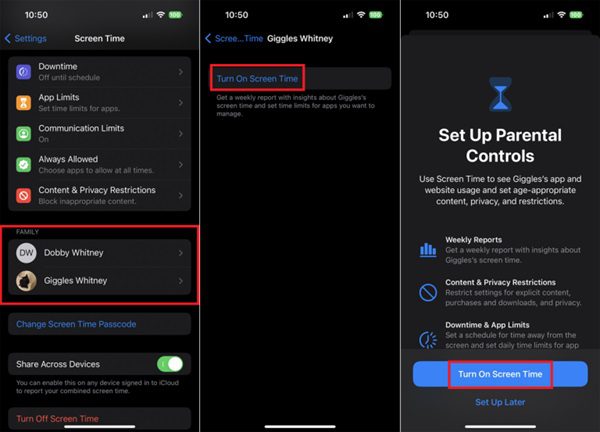


- Or, tap “Turn Off Screen Time”, it requires your Screen Time passcode.
- Confirm that you want to exempt your child’s device from Screen Time.
The mentioned steps would allow you to remotely disable the Screen Time app on your child’s device, thereby removing all app limits, downtime schedules, and content restrictions you set up.
This feature is very helpful when children need to be granted temporary permissions or their Screen Time settings are changed without actually going to their device.
To turn off Screen Time on your child’s device remotely, the device should be connected to the internet and part of your Family Sharing group.
Besides, you need a Screen Time passcode so that you can access and control the settings remotely.
How to limit kids’ screen time without the worry of being turned off?
While the Apple Screen Time function has great potential for controlling children’s device usage, there is a high risk of kids bypassing or turning it off if they know the passcode.
To make parental control more effective without the fear of parental control being blocked or disabled, you can opt for the use of a third-party parental control program like FlashGet Kids.
FlashGet Kids is a comprehensive digital parental control solution that enables you to control what your child is doing on their device through your device.
How to set up FlashGet Kids to limit screen time?
1. Download and install the FlashGet Kids app for parents on your phone. Sign up for your FlashGet account.
2. Next, download and install the kid’s version of the app on your child’s phone.
3. Bind two devices with a 9-digit code. You’ll get this code from your app.
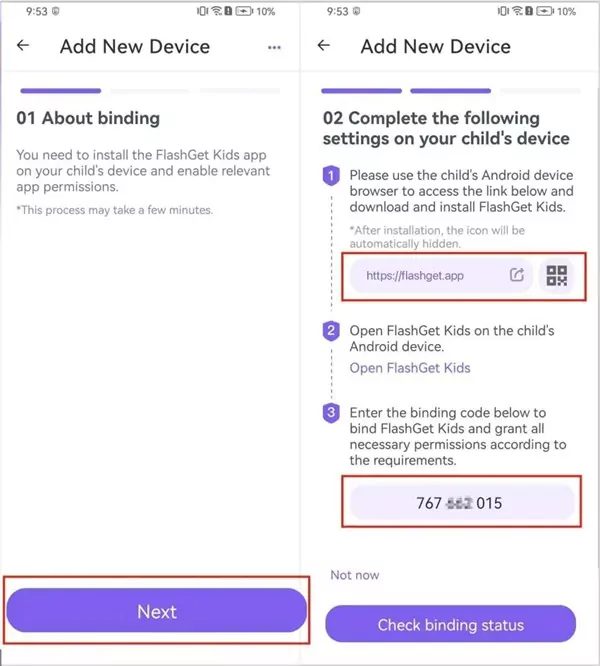


4. On your parental control dashboard, check “Usage Limits” > “Screen Time Limits”.
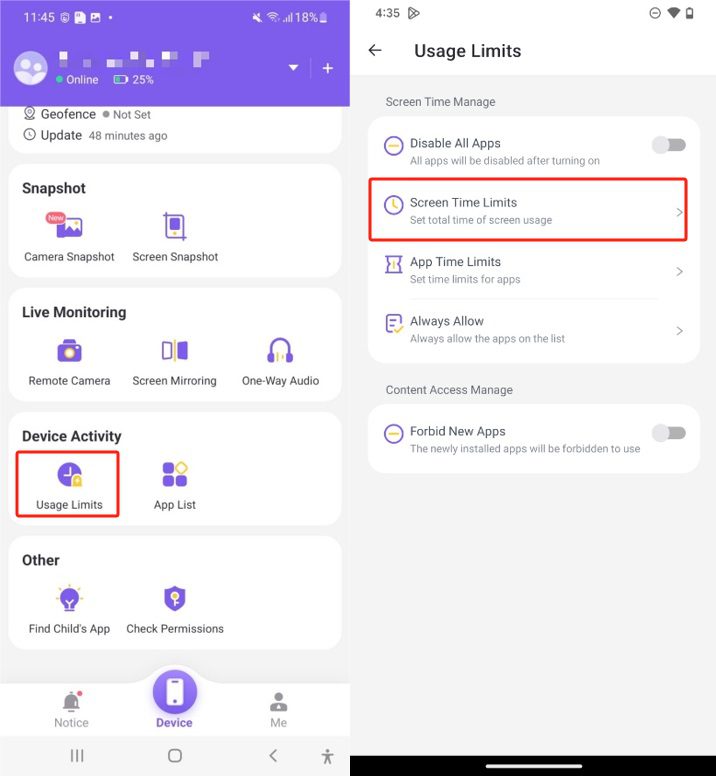


5. Decide on the “Limit Type” you want to use. You can set “Available Time Limits” and “Timespan Limits”. Once you’re done, tap “Save”.
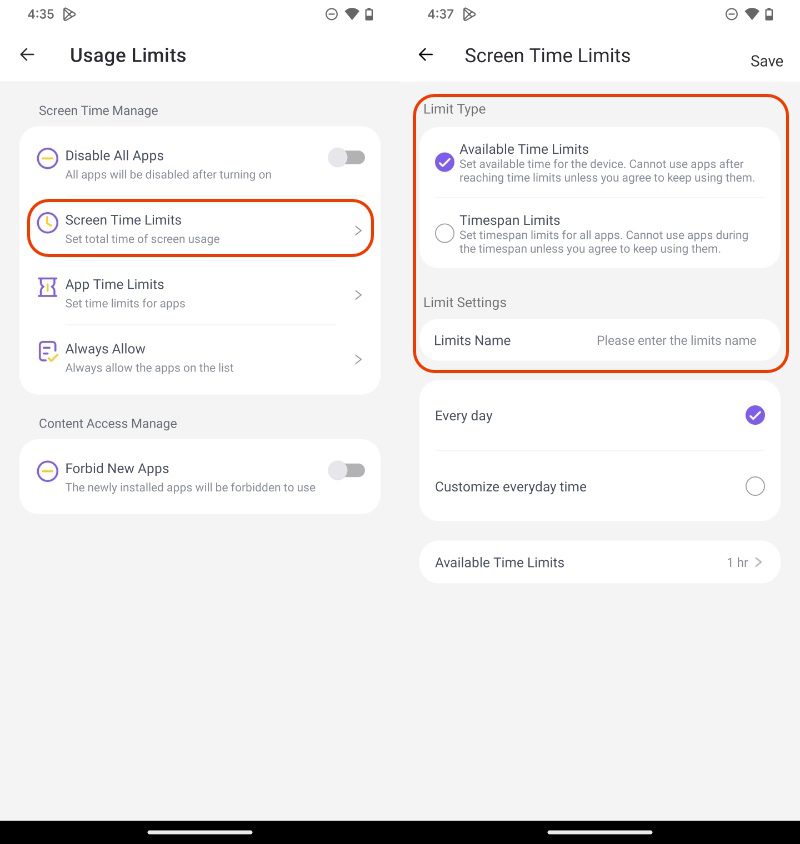


You can also choose to block certain apps or web pages during specified time frames or completely block them.
A benefit of FlashGet Kids is that it does not use the passwords your child might accidentally be able to find.
Instead of being directly controlled from your kids’ device, the app is managed remotely from your device. Thus eliminating the option for kids to circumvent the rules you have set.
Furthermore, FlashGet Kids has features such as real-time location tracking, web filtering, and activity reports to give you the whole picture of your child’s device usage and online activities.
Final Words
The Screen Time setting from Apple is a useful practice for those parents who endeavor to instruct their children on good device behavior.
On the one hand, this does not mean that teenagers that are good at computers will not be able to find a way around these limitations.
Through the use of good security measures, advancing real-time communications and researching 3rd-party parental control apps parents can be confident that they are in charge of their kids’ device time.
To sum up, early detection and reinforcing the safe use of technology make a huge difference in influencing children to uphold socially balanced digital lives.

